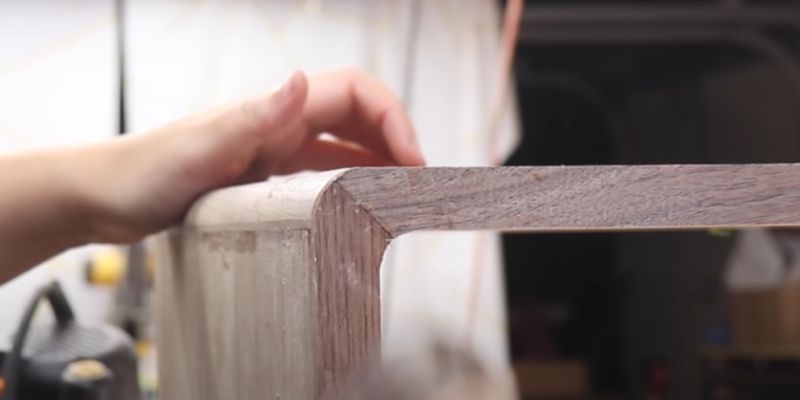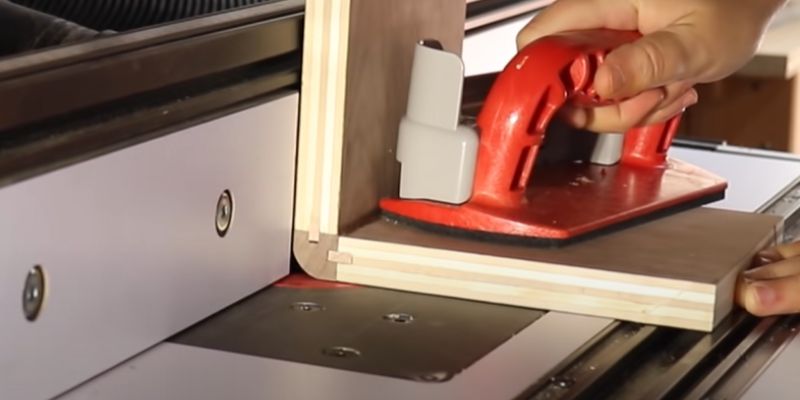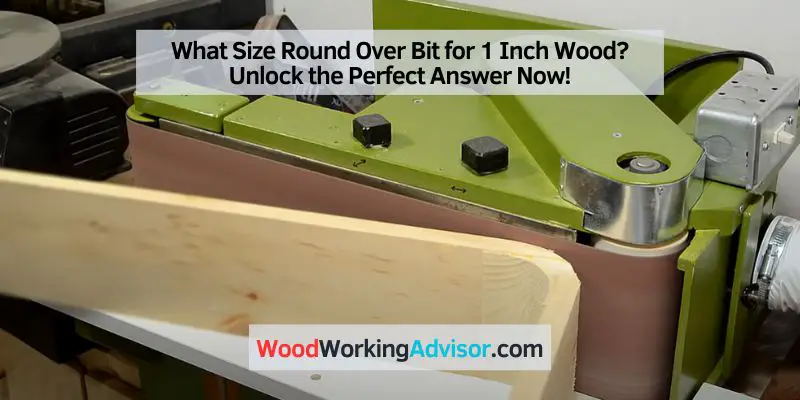For 1 inch wood, a recommended size for a round-over bit would be 1/4 inch. A round-over bit is a versatile tool used to create a smoothly rounded edge on wooden surfaces.
When working with 1 inch thick wood, a 1/4 inch round-over bit is ideal for achieving clean and professional-looking results. This size provides the right balance between the amount of wood being removed and the smoothness of the curved edge.
Whether you are crafting furniture, building cabinets, or working on any woodworking project, using a 1/4 inch round-over bit will help you achieve the desired finished look. It’s important to select the right bit size according to the thickness of the wood to ensure precision and accuracy in your work.
Understanding Round Over Bits
For 1-inch wood, the size of the round over bit to use depends on the desired edge radius. Select a round over bit with a radius that matches your preferences, and it will help you achieve smooth and rounded edges.
What Is A Round Over Bit?
A round-over bit is a type of router bit that is commonly used in woodworking. It is designed to create a rounded edge, or “round over,” on the corners of a piece of wood. This can be a decorative feature that adds a smooth, finished look to the wood, as well as making it safer to handle by eliminating sharp edges.
How Does A Round-Out Over Bit Work?
A round-over bit typically consists of a cylindrical body with a cutting edge that curves outward. When the router equipped with the round-over bit is guided along the edge of the wood, the spinning bit cuts away the sharp edge, creating a curved profile. The depth of the cut can be adjusted by the user to achieve the desired size of the round-over.
Understanding round over bits is essential if you’re working with 1-inch thick wood and want to achieve a specific size of round over. Let’s delve deeper into the details.

Choosing The Right Round Over Bit Size For 1-inch Wood
When it comes to selecting the appropriate round over bit size for your 1-inch wood, it’s essential to consider your desired finished look and the level of detail you’re aiming for. Here are a few key points to keep in mind:
- Bit Radius: The radius of the round over bit determines the size and curve of the profile it creates. For 1-inch wood, you’ll likely want a round over bit with a smaller radius to achieve a tighter curve. A smaller radius, such as 1/4-inch or 3/8-inch, would be suitable for achieving a subtle and more delicate round over.
- Depth of Cut: In addition to the bit radius, the depth of cut also affects the overall size of the round over. If you want a shallower round over, you can adjust the cutting depth accordingly. Keep in mind that the depth of cut should be less than the thickness of the wood to avoid cutting through entirely.
By understanding the different factors that influence the size and shape of the round over, you can make an informed decision on the round over bit size that suits your desired outcome for your 1-inch wood.
Conclusion
Choosing the right round over bit size for your 1-inch wood allows you to achieve the desired rounded edge while maintaining control over the level of detail. By considering factors such as bit radius and depth of cut, you can create a smooth and finished look that adds both aesthetic appeal and safety to your woodworking projects.
Choosing The Right Size Round Over Bit
When it comes to woodworking, adding a round over edge to your project can give it a smooth and attractive finish. However, choosing the right size round over bit is crucial to achieve the desired result. In this article, we will explore the factors to consider when selecting a round over bit for 1-inch wood, and provide you with a list of common round over bit sizes to help you make an informed decision.
Factors To Consider
Before diving into the specific sizes, there are a few factors to consider when choosing a round over bit. These factors include:
- Desired edge profile: Think about the shape and size of the round over edge you want to achieve. Different round over bit sizes will create different curves, so it’s important to take your design preferences into account.
- Wood thickness: The thickness of your wood is a key factor in determining the ideal round over bit size. In this case, we are working with 1-inch wood, so you need to choose a bit that can handle this thickness without causing any issues.
- Router capability: It’s important to check the capability of your router when selecting a round over bit. Ensure that your router is compatible with the bit size you plan to use.
- Project requirements: Consider the specific project requirements. Are you creating a delicate piece that requires a small round over bit, or are you going for a more pronounced edge that might need a larger bit?
Determining The Ideal Size
Once you have taken the above factors into consideration, you can determine the ideal round over bit size for your 1-inch wood by following these steps:
- Measure the wood thickness: Use a caliper or ruler to measure the thickness of your wood. In this case, it is 1 inch.
- Choose the desired round over profile: Based on your design preference, decide on the shape and size of the round over edge you want to achieve.
- Refer to the round over bit size chart: Consult a round over bit size chart, which provides a range of bit sizes and the resulting round over edge radii. Match the desired round over edge to the closest bit size on the chart.
Common Round Over Bit Sizes For 1-inch Wood
Here are some common round over bit sizes suitable for 1-inch wood:
| Bit Size | Round Over Edge Radius |
|---|---|
| 1/8 inch | 1/16 inch |
| 1/4 inch | 1/8 inch |
| 3/8 inch | 3/16 inch |
| 1/2 inch | 1/4 inch |
These are just a few examples, and there are many more round over bit sizes available in the market. Remember, the specific size you choose ultimately depends on your project requirements and desired outcome.
Tips For Achieving The Perfect Round Over
Before you begin using a round over bit on your 1-inch wood, it is crucial to ensure you have the proper set up and have taken necessary safety precautions. Here are a few tips to help you achieve a smooth and safe round over:
- Choose the right round over bit size: When working with 1-inch wood, it is essential to select the appropriate round over bit size. Typically, a 1/4-inch round over bit is ideal for achieving a balanced and aesthetically pleasing edge. It provides just the right amount of roundness without going too deep, which can weaken the wood or cause it to splinter.
- Mount the round over bit securely: Make sure to mount the round over bit securely in your router. Check for any looseness or wobbling of the bit, as this can result in an uneven or unsatisfactory round over.
- Wear appropriate safety gear: Safety should always be a priority when working with power tools. Wear safety glasses to protect your eyes from wood chips or debris. Additionally, wearing ear protection and a dust mask can help minimize the impact of noise and prevent inhalation of dust particles.
Now that you have set up your round over bit and taken necessary safety precautions, it’s time to focus on techniques that will help you achieve smooth and professional-looking edges. Here are some tips:
- Start with a shallow pass: To avoid any mishaps or mistakes, begin by making a shallow pass into the wood. This initial pass will help create a guide for the subsequent passes and ensure a consistent round over.
- Take multiple passes: Instead of trying to achieve the desired round over in a single pass, it’s best to make multiple passes with increasingly deeper cuts. This gradual approach will allow for better control and a smoother finish.
- Keep a steady pace: Maintaining a steady pace as you guide the router along the wood will help prevent any unnecessary chattering or uneven cut lines. Be patient and let the bit do the work.
- Consider using a router table: If you have access to a router table, utilizing it can provide added stability and precision. The flat surface of the table allows for better control and reduces the chance of accidental slips or mistakes.
Once you have achieved the desired round over on your 1-inch wood, it’s essential to finish and sand the edges for a polished and professional look. Here are a few tips:
- Remove any burrs: After rounding over the edges, check for any burrs or rough spots. Use a file or sandpaper to carefully remove any imperfections and create a smooth finish.
- Sand the edges: To achieve a flawless and refined edge, sand the rounded-over area with progressively finer grits of sandpaper. Start with a coarser grit and work your way up to a finer one. This process will help eliminate any remaining roughness and create a silky-smooth surface.
- Apply a finish: To enhance the beauty of the wood and protect the rounded edges, consider applying a suitable finish. Whether it’s a clear varnish, oil, or stain, the choice of finish will depend on your preferences and the intended use of the wood.
By following these tips for achieving the perfect round over on 1-inch wood, you can create beautifully finished projects with smooth and professional edges. Remember to always prioritize safety and take your time to ensure the best results.

Frequently Asked Questions On What Size Round Over Bit For 1 Inch Wood
What Size Round Over Bit Should I Use For 1-inch Wood?
For a 1-inch wood project, it is recommended to use a round-over bit with a radius of 1/8 inch. This will create a smooth, rounded edge that adds beauty and safety. Remember to adjust the bit height to achieve desired results and to always wear safety goggles and follow manufacturer’s instructions.
Conclusion
To conclude, selecting the right round over bit size for 1-inch wood is crucial for achieving the desired results in your woodworking project. By considering factors like the profile you want to achieve and the depth of cut, you can make an informed decision.
Remember to match the bit size with the thickness of the wood to ensure precision and safety while working. So, take your time, assess your needs, and choose the appropriate round over bit for perfect woodworking results.



One thought on “What Size Round Over Bit for 1 Inch Wood? Unlock the Perfect Answer Now!”